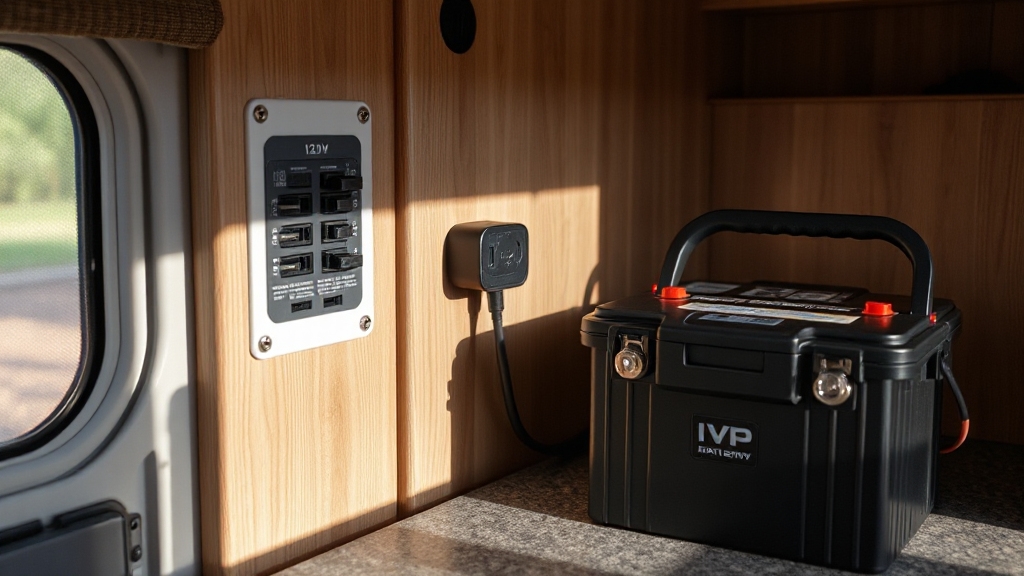Last Updated on May 25, 2025
RV outlets don’t run directly off your RV’s 12V battery because they require 120V AC power. To power them on battery, you’ll need an inverter that converts DC from your house batteries into usable AC voltage.
Keep in mind, inverter capacity and battery size limit how many outlets and appliances you can use simultaneously. Efficient power management and proper battery maintenance are vital for reliable performance.
Exploring these elements can reveal how to optimize your RV’s electrical setup effectively.
Key Takeaways
- RV outlets provide 120V AC power and require an inverter to convert 12V DC battery power for operation.
- Without an inverter, batteries cannot directly power standard RV outlets.
- Inverter capacity and efficiency determine which outlets and appliances can run reliably on battery power.
- Heavy outlet loads drain batteries quickly and may cause safety shutdowns in limited amp systems.
- Proper battery maintenance and load management optimize outlet operation time when running on battery power.
Understanding RV Electrical Systems
Although RV electrical systems can seem complex, understanding their core components and power flows is essential for effective use and maintenance. You’ll find batteries serving as your primary DC power source when shore power or generators are unavailable, and proper battery maintenance is crucial to ensure reliability.
Understanding your RV’s core electrical components is key to effective use and maintenance. Inverters convert this 12V DC battery power into 120V AC to run appliances.
Conversely, converters transform 120V AC from shore power or generators into 12V DC, charging batteries and powering low-voltage systems like lights and fans. High-power devices such as air conditioners and microwaves require 120V AC and typically depend on either shore power or a generator rather than batteries alone high-power devices.
The transfer switch automates switching between power sources, ensuring seamless operation. DC power flows directly from batteries to devices, while AC power originates from external sources or generators. Fuse panels distribute power safely, protecting circuits from overcurrent.
Differences Between Starting and House Batteries
Your RV’s electrical system relies on two distinct types of batteries, each engineered for specific functions that affect performance and longevity. Starting batteries deliver high current bursts (measured in Cold Cranking Amps) to start the engine, optimized with thinner lead plates for rapid discharge.
Conversely, house batteries deep-cycle types supply steady, continuous power for appliances, rated by Reserve Capacity and Amp Hours to sustain longer use. Using starting batteries for house applications risks premature wear due to their inability to handle repeated deep discharges.
House batteries are typically connected in parallel to increase capacity, which helps extend available power for RV systems. Many RV owners also complement house batteries with energy-efficient LED lighting, such as 921 LED bulbs, to maximize power savings and battery life.
House batteries tolerate frequent cycles, with thicker plates and, in lithium variants, enhanced depth of discharge and lifespan. Physically, house batteries can be larger but often lighter and more versatile in installation.
How Standard RV Outlets Are Powered?
When you use standard RV outlets, they rely primarily on an external AC power source, such as shore power or a generator, to operate. These outlets are part of the RV’s 120-volt AC electrical system, which runs separately from the 12-volt DC system powering lights and appliances.
High-quality lithium batteries can enhance the overall system by providing reliable DC power for other RV needs. The battery bank supplies DC power but can’t directly operate standard outlets without converting voltage.
Without additional equipment like an inverter, the 12-volt battery cannot generate AC power required for these outlets. Shore power or a generator feeds AC electricity into the RV’s distribution panel, allowing outlets to function.
This setup guarantees your outlets receive consistent and adequate power, while the converter/charger handles battery maintenance by converting AC to DC. To power these outlets from batteries, an inverter is required to convert the 12-volt DC into usable 120-volt AC power conversion.
Role of Inverters in Running RV Outlets
Since standard RV outlets require 120-volt AC power, inverters play a critical role by converting the 12-volt DC power stored in your RV batteries into usable AC electricity.
Without an inverter, your battery’s DC power can’t run typical household appliances plugged into RV outlets. The inverter’s efficiency and capacity directly impact how effectively your devices function and how long your battery lasts.
Choosing an inverter with a suitable power capacity ensures that all connected devices operate efficiently without overloading the system. Note that the inverter cannot charge the RV batteries but only converts existing power into AC, so managing your power sources efficiently is crucial for off-grid living power conversion only.
When selecting or using an inverter, consider:
- Type of inverter (pure sine wave vs. modified sine wave) for device compatibility and power quality
- Power capacity to match or exceed the wattage demands of your connected appliances
- Efficiency rating to minimize energy loss during DC-to-AC conversion and prolong battery life
Limitations of Using Batteries for RV Outlets
Although RV batteries provide essential power storage, they impose significant limitations on outlet use due to their voltage, capacity, and current constraints. You’ll find that RV batteries supply 12-volt DC power, requiring an inverter to convert it to 120-volt AC for standard outlets.
Moreover, the battery’s maximum current rating restricts continuous high-load usage; running appliances like microwaves or air conditioners quickly depletes the battery and risks overheating wiring or tripping breakers. Voltage drops and battery discharge reduce inverter output, causing unstable outlet power and potential device underperformance.
Safety systems often disable outlets when loads exceed battery limits to prevent damage. Therefore, while batteries can power small devices briefly, their inherent electrical and safety constraints limit reliable, extended outlet operation.
Using a WiFi booster can help maintain connectivity without significantly increasing power demands on battery-powered outlets.
Battery Capacity and Its Impact on Outlet Usage
You need to size your battery bank based on the total power draw of your RV appliances to guarantee reliable outlet operation. Accurately estimating runtime requires calculating the amp-hour capacity relative to the load demands.
Proper battery sizing is essential because deep cycle batteries should not be discharged beyond 50% to maintain longevity. Choosing the right battery type, such as an AGM battery, can significantly affect performance and maintenance requirements.
Battery Size Importance
When selecting a battery size for your RV, understanding how capacity affects outlet usage is essential. Your battery bank determines how long and how many outlets you can power without recharging. Larger capacities provide extended usage periods and support multiple devices simultaneously.
Since RV outlets rely on inverters converting DC battery power to AC, battery size directly impacts your system’s efficiency and reliability. Additionally, monitoring battery performance with a battery monitor helps prevent unexpected power loss and extends battery life.
Consider these factors when sizing your battery bank:
- Usage Duration: Longer off-grid stays require higher amp-hour capacities to maintain outlet function.
- Device Quantity: More outlets or high-demand appliances need larger battery banks to avoid rapid depletion.
- Charging Access: Limited charging opportunities demand bigger batteries to sustain power between charges.
Because RV electrical systems integrate both AC and DC power sources, battery capacity must be matched with the inverter size to properly supply AC outlets.
Power Draw Considerations
Selecting the right battery size sets the foundation, but understanding how power draw affects outlet usage sharpens your ability to optimize energy consumption. RV batteries, often lithium with capacities like 100 amp-hours, power 12-volt DC outlets directly.
While AC outlets require inverters that introduce efficiency losses. You must calculate amperage by dividing appliance wattage by battery voltage; for example, an 850-watt device draws roughly 71 amps at 12 volts.
Managing load is critical heavy draws reduce battery life and may exceed your RV’s power limits (e.g., 30- or 50-amp systems), risking system overload. Prioritizing essential appliances and monitoring current draw helps prevent premature battery depletion or damage.
Accurate load assessments ensure your battery capacity aligns with outlet demands, maintaining safe, effective power distribution throughout your RV. Using high-quality sealants regularly, as recommended for trailer maintenance, can similarly protect your RV’s power systems from environmental damage and prolong their operational life.
Runtime Estimation Methods
Although battery capacity provides a baseline for potential runtime, accurately estimating how long your RV outlets can operate depends on converting that capacity into usable energy and accounting for load characteristics.
You start by converting ampere-hours (Ah) to watt-hours (Wh) using battery voltage, then adjust for usable capacity—typically 50% for lead-acid and up to 100% for lithium batteries.
Next, divide this usable Wh by your device’s wattage and multiply by an efficiency factor (usually 0.8 to 0.9) to account for inverter losses. Key considerations include:
- Battery chemistry impacts usable capacity and depth of discharge limits.
- Efficiency factors reflect real-world system losses.
- Load variability affects current draw and runtime accuracy.
- Understanding battery capacity is essential, as it determines how much energy the battery can store and provide.
- Additionally, the presence of a Battery Management System (BMS) can enhance safety and optimize usable capacity during discharge.
Charging Solutions to Support Battery-Powered Outlets
Because maintaining reliable power to battery-powered outlets is critical for RV functionality, understanding effective charging solutions is essential. You can use inverter chargers to convert DC from batteries to AC for appliances while charging batteries via shore power or generators.
Selecting adhesives with temperature resistance ensures reliable performance in varied environmental conditions that RVs often encounter. Reliable power to battery outlets is vital for RVs; inverter chargers enable AC use while charging from shore or generators.
Portable power stations like Jackery or EcoFlow provide AC/DC outputs and can charge via standard 120V outlets, solar panels, or car DC systems, offering versatility and mobility. However, currently, there are no portable power stations available in the market, which may affect immediate purchasing options.
Solar charging offers sustainable recharging, especially with panel arrays, accelerating charge times. High-amperage chargers efficiently replenish batteries but require compatibility checks to prevent damage.
Combining dual AC and solar inputs optimizes charging speed. Selecting the right inverter and matching battery types ensures efficient power delivery. These solutions balance efficiency, versatility, and rapid recharge capabilities, enabling continuous and reliable operation of battery-powered RV outlets.
Safety Considerations When Running Outlets Off Batteries
When running outlets off batteries, you must prioritize safety protocols to prevent electrical hazards and equipment damage. Begin by ensuring proper grounding and using insulated tools to avoid accidental shorts.
Disconnect the negative terminal first to minimize risk, and always wear protective gear like safety glasses. Remove all metallic jewelry before working on the battery to avoid short circuits and burns.
Monitor battery temperature closely, as overheating can cause fires or explosions. Key safety measures include:
- Installing circuit breakers or fuses to protect against overloads and prevent damage.
- Maintaining good ventilation to avoid hydrogen gas buildup and prohibiting open flames nearby.
- Securing cables properly and regularly inspecting wiring insulation to prevent electrical faults.
Alternatives to Battery-Powered RV Outlets
If you need reliable power without relying solely on traditional battery setups, several alternatives can efficiently supply electricity to your RV outlets. Portable power stations offer flexible AC/DC outputs, rapid recharging via solar, wall, or car chargers, and can handle both small and large loads.
Most modern units use LiFePO4 battery technology, which provides safer operation and longer cycle life compared to conventional batteries. Their plug-and-play design eliminates complex installations, making them ideal for varied RV needs.
Here’s a quick comparison to help you assess options:
| Feature | Benefit |
|---|---|
| Power Source Flexibility | Multiple recharge methods |
| Ease of Use | No rewiring; portable design |
| Capacity & Expandability | From small appliances to full RV load |
| Versatility | Multiple ports (USB, AC, DC) |
| Cost & Availability | Wide price range; broadly available |
Tips for Extending Battery Life While Using Outlets
Exploring alternatives to traditional battery-powered RV outlets highlights the importance of managing your existing battery resources effectively.
To extend battery life while using outlets, you must minimize unnecessary power draw and maximize energy use. Since RV inverters are not 100% efficient and convert DC battery power into AC power with some energy loss, choosing an inverter with high efficiency ratings can significantly reduce wasted power.
Start by limiting outlet use to essential devices only, prioritizing low-power appliances and efficient inverter systems to reduce conversion losses. Regular battery maintenance and smart charging strategies, like trickle charging, maintain ideal capacity.
Limit outlet use to essentials and maintain batteries with efficient charging to maximize capacity and reduce losses. Consider these key tips:
- Limit outlet operation to critical devices and use power strips to control usage efficiently.
- Select high-efficiency inverters to reduce power loss during DC to AC conversion.
- Employ battery monitors to track consumption and prevent over-discharge, extending battery longevity.
Frequently Asked Questions
Can RV Batteries Power USB Outlets Without an Inverter?
Imagine charging your phone directly from your RV’s battery during a camping trip without any power hookups. Yes, you can power USB outlets straight from RV batteries because these outlets use 12V DC power, which batteries supply naturally.
Unlike standard AC outlets, USB ports don’t need an inverter to convert the current. This setup improves efficiency by avoiding energy loss through conversion, making your off-grid charging practical and reliable.
How Do Lithium Batteries Compare to Lead-Acid for RV Outlet Use?
You’ll find lithium batteries outperform lead-acid for RV outlet use due to higher usable capacity (80–100%), providing longer, more consistent power without voltage drops. They’re lighter, enhancing RV weight efficiency and installation flexibility.
Lithium’s extended lifespan (up to 5,000 cycles) reduces replacements and maintenance. Although pricier upfront, their efficiency and durability lower long-term costs. Lead-acid batteries, by contrast, offer less capacity and degrade faster, limiting outlet performance.
What Size Inverter Is Best for Common RV Appliances?
Since an air conditioner can demand around 3500 watts including surge, you’ll want an inverter rated at least 3000 watts continuous to handle common RV appliances safely. Most RVs use 2000- to 3000-watt inverters, balancing power and efficiency.
Calculate total wattage by adding appliance running and surge watts, then add 20% extra for startup surges. Choose a pure sine wave inverter to defend sensitive electronics and guarantee reliable performance.
Are There RV Outlets That Work Directly on 12V DC?
Yes, you’ll find RV outlets that operate directly on 12V DC power, eliminating the need for an inverter. These outlets power low-voltage devices like vacuums, fans, and coffee makers straight from your RV’s battery system.
They include standard cigarette-lighter sockets, dual USB combos, and specialized types like Engel outlets designed for secure, high-current connections. Proper installation with correct wiring and grounding is vital to guarantee safe, efficient operation.
Can Portable Power Stations Replace RV House Batteries?
You can use portable power stations to replace RV house batteries for light to moderate power needs. They offer plug-and-play convenience, integrated inverters, and multiple outlets, reducing setup complexity.
However, they may lack the capacity and surge power for heavy loads like air conditioners. For extended or high-demand use, traditional RV house battery systems remain superior in scalability and integration. Choose based on your power requirements and portability preferences.
From DC to AC: Making Your RV Outlets Work Off-Grid
You can power RV outlets from batteries, but it’s like trying to run a full kitchen on a single candle limited and requiring careful management. Understanding your electrical system and using inverters effectively is essential to avoid draining your batteries prematurely.
To optimize performance, invest in proper charging solutions and monitor usage closely. By balancing power demands with battery capacity, you’ll maintain functionality without risking system failure or safety hazards.



